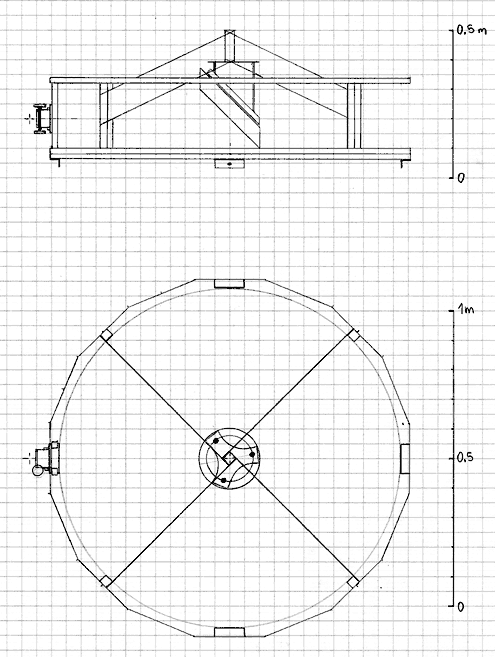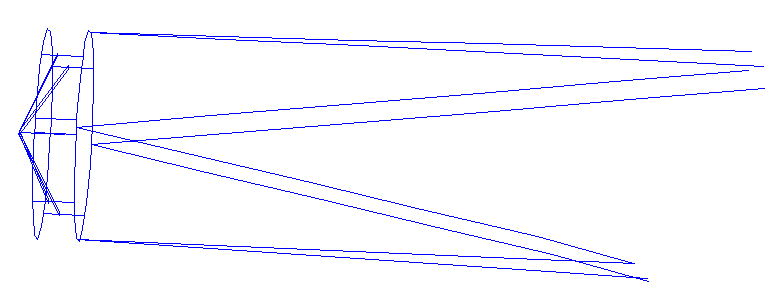|
Design of the Upper Cage
Click here to view the construction page of the Upper Cage.
- General design: Single ring or full cage?
- Two main designs are possible for the upper cage.
- A single ring design is lighter, more compact (in height) to transport, and less prone to wind.
- A double ring design or full cage provides better protection for the secondary mirror during transport, reduces the truss tube length,
simplifies the mounting of the focuser and spider vanes, and is inherently stiffer (especially for torsion of the rings).
Both designs are perfectly acceptable, it's a matter of personal preference and design priorities.
- After due consideration of the advantages and drawbacks of each option, the double ring design is selected.
Over-all the secondary cage will look like in the following drawings:

- Use of a mounting ring
- The upper cage of the Cruxis Telescope will be 121 cm (4 ft) wide and 274 mm (11") high and will weigh about 12 kg (26 lbs).
It is impossible for a single person to carry the complete upper cage 4 meter on a ladder to mount it on top of the truss tubes.
It's not just the weight but also the sheer bulk of the cage that makes this practically impossible.
- To address this problem, mounting the cage will be done in 3 steps:
- A lightweight mounting ring (about 2 kg - 4 lbs) is attached to the truss tubes.
- The telescope is lowered to nearly horizontal position.
- The rest of the upper cage (weighing about 8 kg or 18 lbs) can then be fixed on the mounting ring while standing on the ground.
- Overall dimensions
- The three rings (the mounting ring and two cage rings) will be made from 18 mm (3/4") baltic birch plywood.
The inner diameter is 115 cm, the outside is a 16-sided polygon with outer diameter of 121 cm.
Each ring weighs about 1.5 kg (3.3 lbs).
- The cage rings will be connected by four 220 mm long 30x1.5 mm square aluminum tube, on which the spider vanes will be mounted.
The focuser is mounted on two 20x1.5 mm square aluminum tubes.
The total height of the upper cage is 3 x 18 mm + 220 mm = 274 mm, sufficient to protect the 200 mm secondary mirror.
- Secondary mirror
- For more details see the Secondary Mirror Design page.
- The focal plane is designed at 675 mm from the optical axis. This value is obtained as follows:
575 mm (inner radius of cage) + 25 mm (position of focuser base) + 56 mm (minimum height of focuser) + 19 mm (height of focal point) = 675 mm.
- A 200 mm (7.9") minor axis secondary will create a 37 mm (1.45") fully illuminated field.
- The secondary mirror requires a 12 mm (1/2") offset away from the eyepiece to keep the optical axis in the center of the upper cage.
- The secondary mirror holder is mounted on a spider with double vanes that are offset from the center.
- Because of the offset, the spider vane thickness can be much reduced and there is no requirement for tensioning as in a spider with central vanes.
The torsion stiffness of the secondary mirror assembly is greatly enhanced because the rotation around the optical axis does not provoke bending
but only traction/compression of the vanes.
- In this design sufficient stiffness is obtained by either 1 mm (0.04") thick aluminum or 0.5 mm (0.02") thick steel vanes of about 100 mm (4") width,
which is quite extraordinary considering the 2 kg secondary mirror weight and the 1210 mm span of the vanes.
- Design weight of the different parts of the Upper Cage
- Below a table with the design weight of all the elements of the Upper Cage (1 kg = 2.2 lbs):
| 3 Rings 1210x1150 | 4.5 kg
| | 4 Tubes 30x1.5 mm x 220 mm | 0.4 kg
| | 2 Tubes 20x1.5 mm x 220 mm | 0.1 kg
| | Focuser + motor | 0.7 kg
| | Eyepiece | 0.8 kg
| | Finder | 0.3 kg
| | Light shield | 0.5 kg
| | Spider vanes 100 mm x 1 mm aluminum | 0.7 kg
| | Secondary mirror holder | 1.0 kg
| | Secondary mirror | 2.0 kg
| | Misc. mounting hardware | 1.0 kg
| | Upper Cage | 12.0 kg
|
|---|
- Total weight is 12.0 kg (26 lbs) of which:
- Mounting ring: 2.3 kg (5 lbs) carried on the ladder and mounted on top of the truss tubes
- Bare upper cage: 8.1 kg (18 lbs) fixed on the mounting ring while standing on the ground
- Mobile accessories (finder, eyepiece, shield): 1.6 kg (3 lbs) added afterwards
- The heaviest part of the upper cage will weigh around 8.1 kg (18 lbs)... not too bad for a three ring design on a 110 cm scope!
- Finite element analysis of the upper cage and truss tubes
- A full finite element analysis of the upper cage and truss tubes has been performed.
Move the mouse over the image to see the deflections (magnified 100 times).

- The analysis confirms the following results:
- The gravity sag of the upper cage due to the flexibility of the truss frame is 0.45 mm (0.018"), very close to the approximate value computed on the
Truss Frame page.
- The middle of the tubes sags about 2 mm (0.08") when the scope points horizontally.
- Adding 3 more 30x1.5 mm connection tubes between the 2 upper cage rings improves the stiffness only marginally. The out-of-plane stiffness of the
upper ring of the cage is acceptable with just the 4 tubes shown in the drawing.
| |